What is Endocrine System?
- At the core of the endocrine system is the hypothalamus, located in the brain, which serves as the neural control center. It orchestrates the activities of several endocrine glands, including the pituitary gland, often referred to as the “master gland.” The hypothalamus communicates with the pituitary gland to regulate other glands throughout the body, forming what is known as the hypothalamic–pituitary axis. This interconnectivity illustrates the complexity of hormonal regulation.
- The major glands in the human endocrine system include the thyroid, parathyroid, pituitary, pineal, adrenal glands, as well as the gonads—the ovaries and testes. Each of these glands has specific functions and secretes particular hormones that influence various bodily functions. For instance, the thyroid gland produces thyroxine, which is essential for regulating metabolism. Similarly, the adrenal glands release hormones like cortisol and adrenaline, which are critical in stress response.
- Besides these primary glands, there are other organs that contribute to the endocrine system, albeit not exclusively. For instance, the pancreas plays a dual role as both an endocrine and exocrine organ, secreting insulin and glucagon to regulate blood glucose levels. The kidneys also produce hormones, such as erythropoietin, which is involved in red blood cell production.
- Endocrine glands are characterized by their ductless nature; they release hormones directly into the bloodstream. This distinguishes them from exocrine glands, which have ducts and secrete substances outside the body or into body cavities, such as salivary and sweat glands. The vascularity of endocrine tissues ensures efficient hormone distribution throughout the body, allowing even small quantities of hormones to exert significant effects.
- The regulation of hormone levels in the bloodstream is primarily controlled by negative feedback mechanisms. When hormone levels rise above a certain threshold, the system inhibits further secretion, thereby maintaining balance. This feedback loop is essential for regulating various physiological functions, from growth to electrolyte balance. Moreover, the endocrine system does not operate in isolation; it interacts with the nervous and immune systems, showcasing its integral role in overall body function.
Definition of Endocrine System
The endocrine system is a network of glands that release hormones directly into the bloodstream to regulate various bodily functions, including metabolism, growth, reproduction, and mood. It works in conjunction with the nervous system to maintain homeostasis and coordinate complex processes within the body.
Structure of Endocrine System
The endocrine system comprises a complex network of cells, tissues, and organs that play a critical role in hormone secretion, regulating numerous physiological functions throughout the body. This system is predominantly characterized by the presence of ductless glands that release hormones directly into the bloodstream, thereby influencing various bodily processes. Below is a detailed overview of the structure of the endocrine system:
- Endocrine Glands: The primary components of the endocrine system are the ductless glands. These glands release hormones directly into the interstitial fluid, which then enters the bloodstream for widespread distribution. Key endocrine glands include:
- Pituitary Gland: Often referred to as the “master gland,” it regulates other endocrine glands and secretes growth hormone, prolactin, and others.
- Thyroid Gland: Located in the neck, it produces hormones like thyroxine, which regulate metabolism.
- Parathyroid Glands: Situated near the thyroid, these glands secrete parathyroid hormone, crucial for calcium homeostasis.
- Adrenal Glands: Positioned on top of each kidney, they produce hormones such as cortisol and adrenaline, which are vital for stress response and metabolism.
- Pineal Gland: Located deep within the brain, it secretes melatonin, which regulates sleep-wake cycles.
- Other Organs with Endocrine Functions: Several organs have both endocrine and non-endocrine functions:
- Pancreas: Contains cells that produce digestive enzymes (exocrine function) and hormones like insulin and glucagon to regulate blood glucose levels (endocrine function).
- Hypothalamus: A key regulator that connects the nervous system to the endocrine system via the pituitary gland, influencing hormone release.
- Thymus: Plays a role in immune function and also secretes hormones involved in T-cell development.
- Gonads: The ovaries and testes produce sex hormones, such as estrogen, progesterone, and testosterone, which are vital for reproduction and secondary sexual characteristics.
- Secondary Endocrine Functions in Other Tissues:
- Heart: Produces atrial natriuretic peptide, which regulates blood pressure and fluid balance.
- Kidneys: Secrete hormones like erythropoietin, which stimulates red blood cell production.
- Liver: Produces insulin-like growth factors and various hormones that regulate metabolism.
- Skin: Contains cells that can secrete hormones involved in skin health and metabolism.
- Adipose Tissue: Acts as an endocrine organ by secreting leptin, which regulates energy balance and appetite.
- Bone Tissue: Recent research indicates that bones produce hormones such as osteocalcin, which play roles in metabolism and energy regulation.
- Comparison with Exocrine Glands:
- Endocrine glands are distinct from exocrine glands, which secrete their products through ducts to external surfaces or cavities. Examples include sweat glands and sebaceous glands in the skin, as well as the exocrine functions of the pancreas, which releases digestive enzymes through ducts into the small intestine.
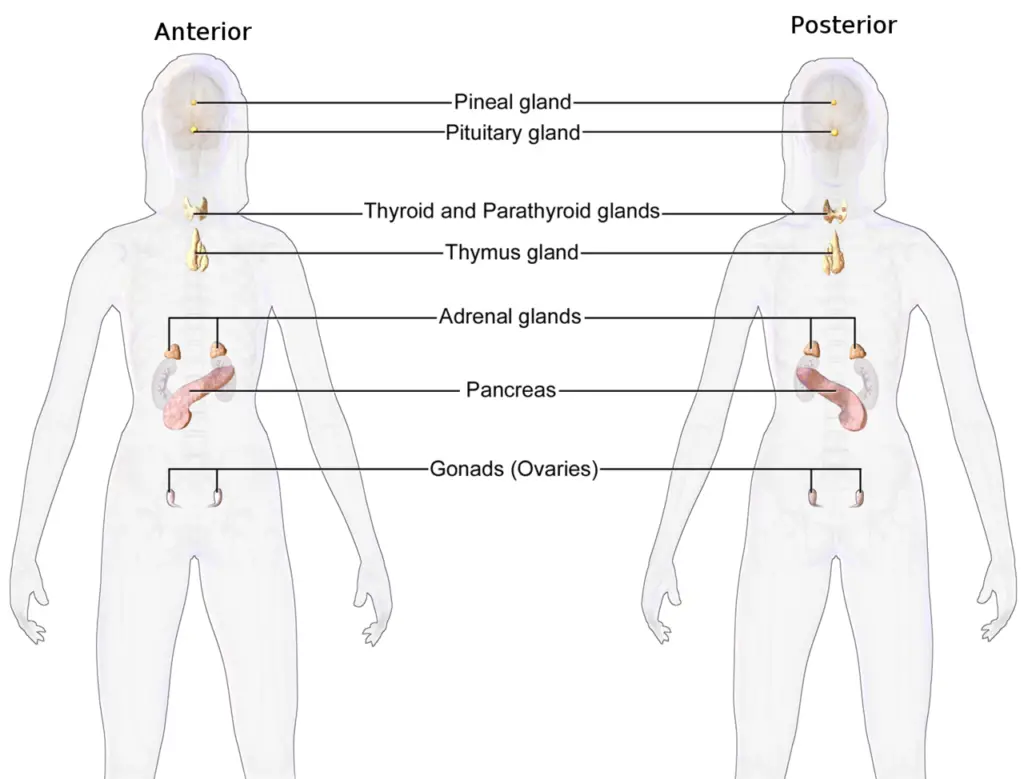
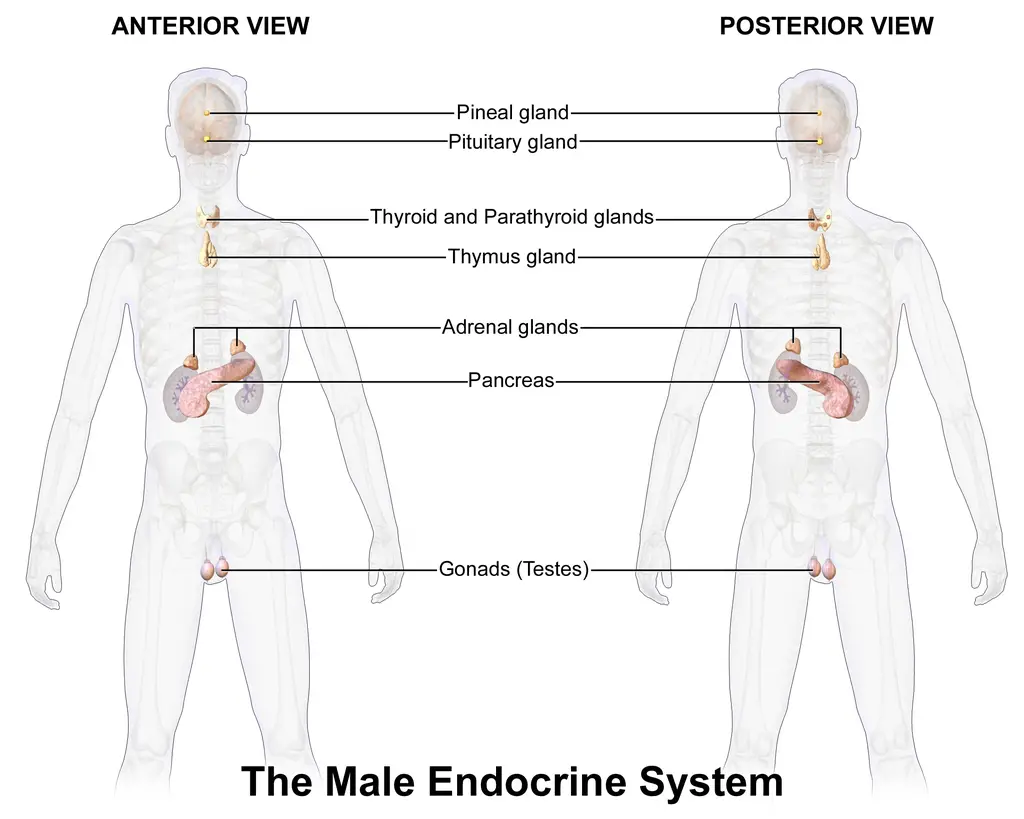
Classification of Endocrine Glands
The classification of endocrine glands can be based on different criteria, including their location, number, and mode of secretion. By categorizing endocrine glands, we can gain a better understanding of their diversity and functions within the vertebrate body.
On the Basis of Location:
- Cranial endocrine glands: These glands are situated in the head region. Examples include the pituitary gland, pineal gland, and hypothalamus. The pituitary gland plays a crucial role in hormone regulation and is often referred to as the “master gland” due to its control over other endocrine glands. The pineal gland produces melatonin, which is involved in regulating sleep-wake cycles. The hypothalamus acts as a bridge between the nervous and endocrine systems, regulating hormone release from the pituitary gland.
- Pharyngeal endocrine glands: These glands are located in the pharyngeal or neck region. The thyroid gland, responsible for producing thyroid hormones that regulate metabolism, is a prominent example. The parathyroid glands, embedded within the thyroid gland, play a vital role in calcium homeostasis.
- Abdominal endocrine glands: These glands are found in the abdominal region. Examples include the pancreas, adrenal glands, testes, and ovaries. The pancreas produces insulin and glucagon, hormones involved in blood sugar regulation. The adrenal glands secrete hormones such as cortisol and adrenaline, which are involved in stress response. The testes produce testosterone in males, while the ovaries produce estrogen and progesterone in females, regulating reproductive processes.
On the Basis of Number:
- Unilateral endocrine glands: These glands exist as a single structure. Examples include the pituitary gland, pineal gland, and pancreas. The pituitary gland, located at the base of the brain, consists of two lobes, the anterior and posterior pituitary, each with distinct hormone-secreting cells. The pineal gland is a single small structure located deep within the brain. The pancreas, although having both exocrine and endocrine functions, is considered a unilateral endocrine gland due to its hormone-secreting islets of Langerhans.
- Bilateral endocrine glands: These glands exist as paired structures. Examples include the thyroid gland, adrenal glands, and parathyroid glands. The thyroid gland, located in the neck on either side of the trachea, consists of two lobes connected by an isthmus. The adrenal glands, situated on top of each kidney, consist of an outer adrenal cortex and an inner adrenal medulla. The parathyroid glands, usually four in number, are small structures embedded within the thyroid gland.
On the Basis of Secretion
- Telecrine glands: These glands release hormones directly into the bloodstream, which then travel to target cells or organs. Examples include the thyroid gland, adrenal gland, and pituitary gland. Hormones produced by these glands have far-reaching effects throughout the body.
- Paracrine glands: These glands secrete hormones that act locally on nearby cells or tissues. Instead of entering the bloodstream, the hormones diffuse through the interstitial fluid to reach adjacent target cells. An example is the islets of Langerhans in the pancreas, where somatostatin secreted by delta cells acts on nearby alpha and beta cells, regulating insulin and glucagon secretion.
By classifying endocrine glands based on their location, number, and secretion patterns, we can appreciate the diversity and specialized functions of these essential components of the endocrine system. Each category of endocrine gland contributes to maintaining homeostasis and regulating various physiological processes within the vertebrate body.
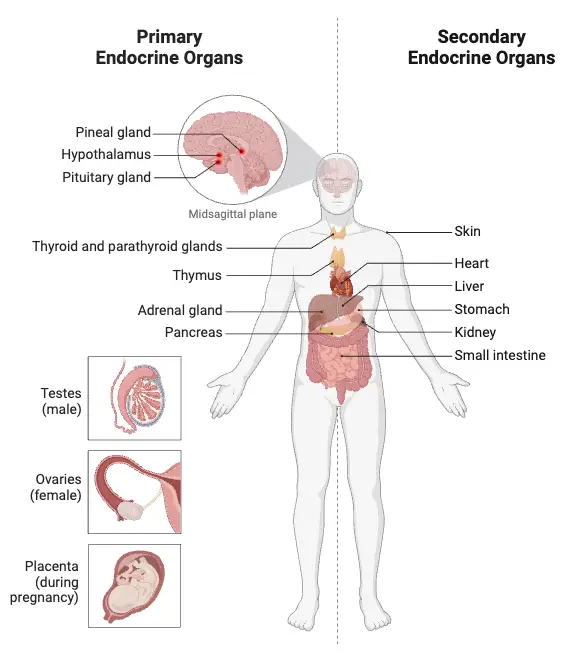
Primary Endocrine Glands and Their Major Hormones
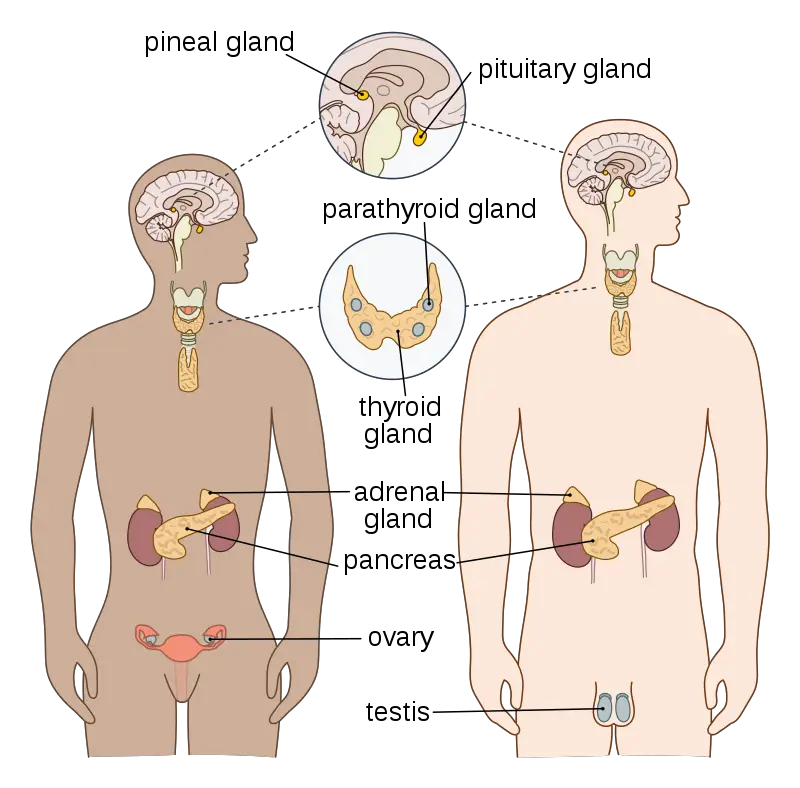
The endocrine system plays a critical role in maintaining physiological homeostasis through the secretion of hormones by various glands. This intricate network of glands produces hormones that regulate numerous body functions, including metabolism, growth, development, and reproduction. Below is a detailed overview of the major endocrine glands and their primary hormones.
- Hypothalamus and Pituitary Gland
The hypothalamus, located below the thalamus in the brain, serves as a key regulator of the pituitary gland, connecting the endocrine and nervous systems. It secretes several hormones that influence the pituitary’s function.- Hormones of the Hypothalamus
- Growth Hormone-Releasing Hormone (GHRH): Stimulates the release of growth hormone (GH) from the anterior pituitary.
- Thyrotropin-Releasing Hormone (TRH): Promotes the secretion of thyroid-stimulating hormone (TSH) from the anterior pituitary.
- Corticotropin-Releasing Hormone (CRH): Triggers the release of adrenocorticotropic hormone (ACTH).
- Prolactin-Releasing Hormone (PRH): Stimulates prolactin secretion; inhibited by prolactin-inhibiting hormone (PIH).
- Gonadotropin-Releasing Hormone (GnRH): Induces the release of luteinizing hormone (LH) and follicle-stimulating hormone (FSH).
- Hormones of the Pituitary Gland
- Growth Hormone (GH): Promotes growth and metabolism in body tissues, particularly in muscles and bones.
- Thyroid-Stimulating Hormone (TSH): Stimulates the thyroid gland to produce thyroid hormones (T3 and T4).
- Adrenocorticotropic Hormone (ACTH): Stimulates the adrenal cortex to produce glucocorticoids, primarily cortisol.
- Prolactin (PRL): Promotes milk production in breastfeeding women.
- Follicle-Stimulating Hormone (FSH): Stimulates ovarian follicle development in females and spermatogenesis in males.
- Luteinizing Hormone (LH): Triggers ovulation in females and stimulates testosterone production in males.
- Oxytocin: Stimulates uterine contractions during childbirth and milk ejection during lactation.
- Antidiuretic Hormone (ADH): Regulates water balance by affecting the kidneys’ ability to reabsorb water.
- Hormones of the Hypothalamus
- Thyroid Gland
The thyroid gland, located in the neck, consists of two lobes connected by the isthmus. It is essential for regulating metabolism and energy levels.- Hormones of the Thyroid Gland
- Thyroxine (T4): Increases the basal metabolic rate (BMR) and regulates various metabolic processes.
- Triiodothyronine (T3): More potent than T4, it also plays a crucial role in metabolism and development.
- Hormones of the Thyroid Gland
- Parathyroid Gland
Located on the posterior aspect of the thyroid gland, the parathyroid glands are crucial for calcium homeostasis.- Hormone of the Parathyroid Gland
- Parathyroid Hormone (PTH): Increases blood calcium levels by promoting calcium release from bones, increasing intestinal absorption of calcium, and decreasing renal excretion.
- Hormone of the Parathyroid Gland
- Adrenal Gland
Positioned atop each kidney, the adrenal glands consist of two parts: the adrenal cortex and adrenal medulla.- Hormones of the Adrenal Glands
- Mineralocorticoids (e.g., Aldosterone): Regulate sodium and potassium levels, influencing blood pressure and fluid balance.
- Glucocorticoids (e.g., Cortisol): Help the body respond to stress, influencing metabolism and immune function.
- Androgens: Precursor hormones that contribute to the development of secondary sexual characteristics.
- Epinephrine (Adrenaline) and Norepinephrine (Noradrenaline): Enhance the body’s fight-or-flight response, increasing heart rate and blood flow to muscles.
- Hormones of the Adrenal Glands
- Pancreas
The pancreas has both endocrine and exocrine functions, with its endocrine component consisting of the islets of Langerhans.- Hormones of the Pancreatic Islets
- Insulin: Secreted by β-cells, it lowers blood glucose levels by promoting cellular uptake of glucose.
- Glucagon: Produced by α-cells, it raises blood glucose levels by promoting glycogen breakdown in the liver.
- Hormones of the Pancreatic Islets
- Pineal Gland
A small gland located in the brain, the pineal gland plays a role in regulating circadian rhythms.- Hormone of the Pineal Gland
- Melatonin: Regulates sleep-wake cycles, with levels peaking at night and decreasing during the day.
- Hormone of the Pineal Gland
- Thymus
The thymus is involved in immune function, particularly during childhood.- Hormone of the Thymus Gland
- Thymosin: Stimulates the development and differentiation of T lymphocytes, essential for adaptive immunity.
- Hormone of the Thymus Gland
- Gonads
The gonads (testes in males and ovaries in females) produce sex hormones that regulate reproductive functions.- Hormones of the Gonads
- Estrogens: Produced in ovaries, they regulate the menstrual cycle and secondary sexual characteristics in females.
- Progesterone: Prepares the uterus for pregnancy and maintains early stages of gestation.
- Testosterone: Produced in the testes, it promotes spermatogenesis and development of male secondary sexual characteristics.
- Hormones of the Gonads
Diagrams of Endocrine Glands
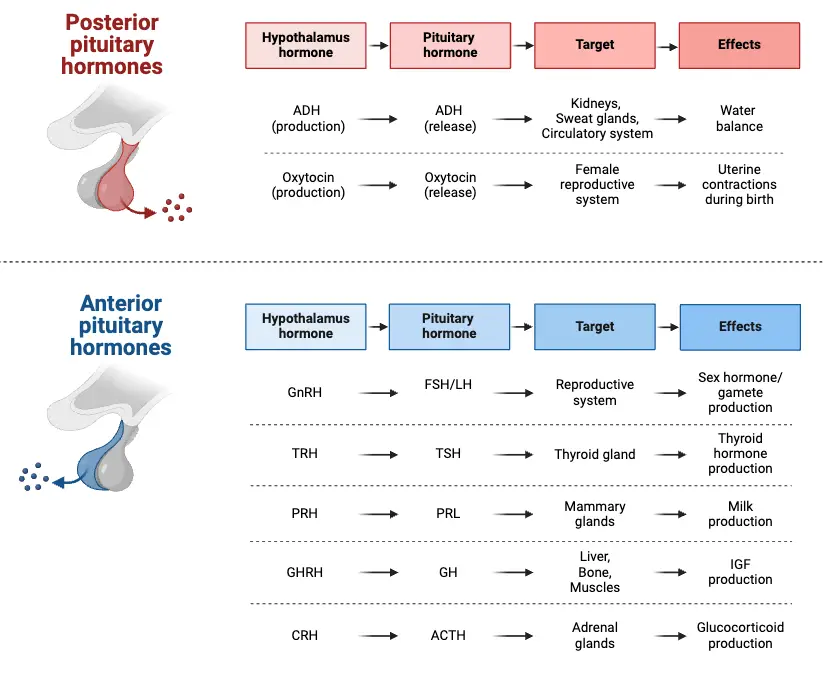
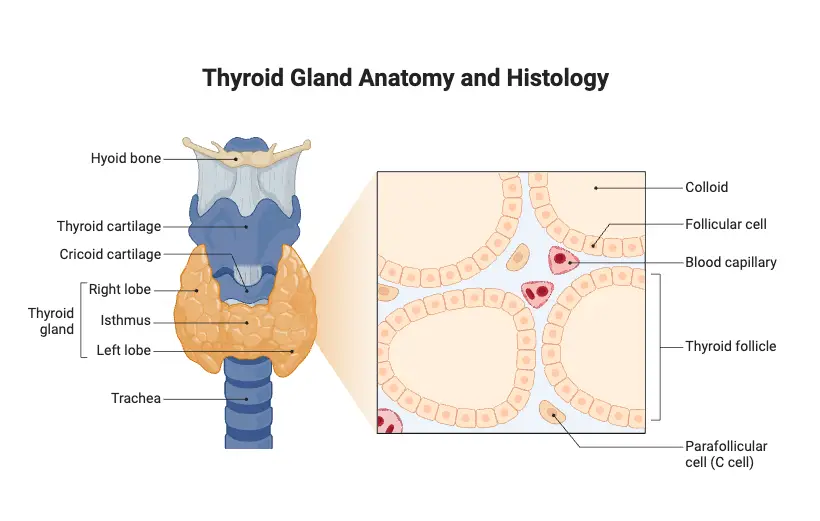
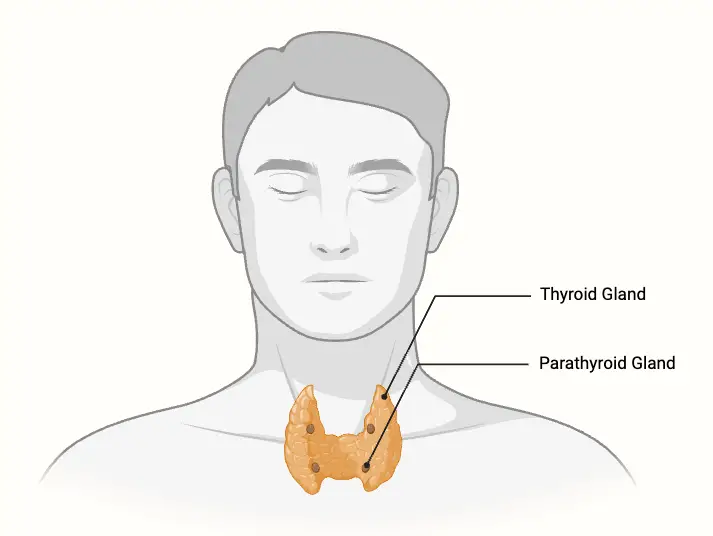
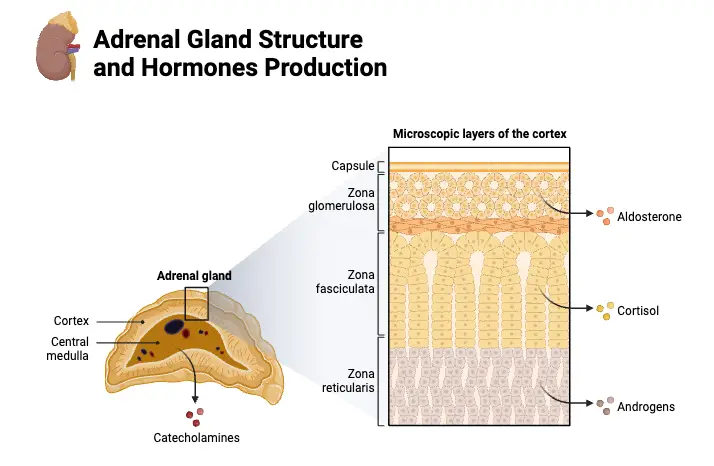
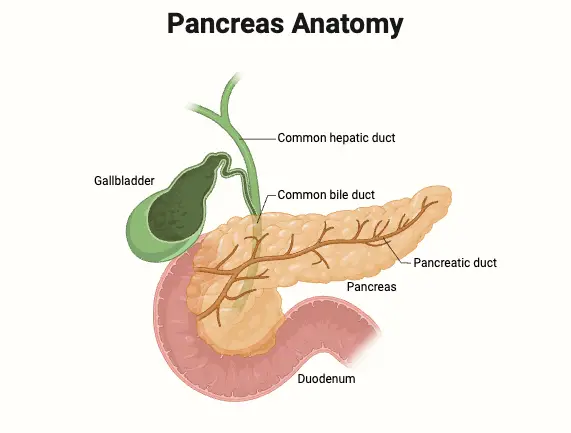
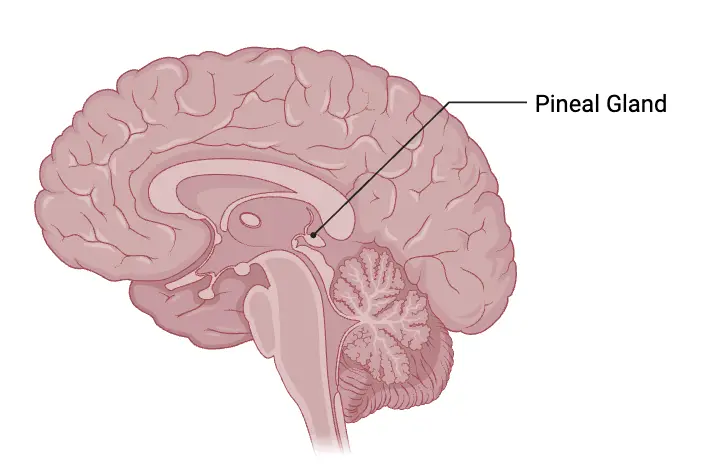
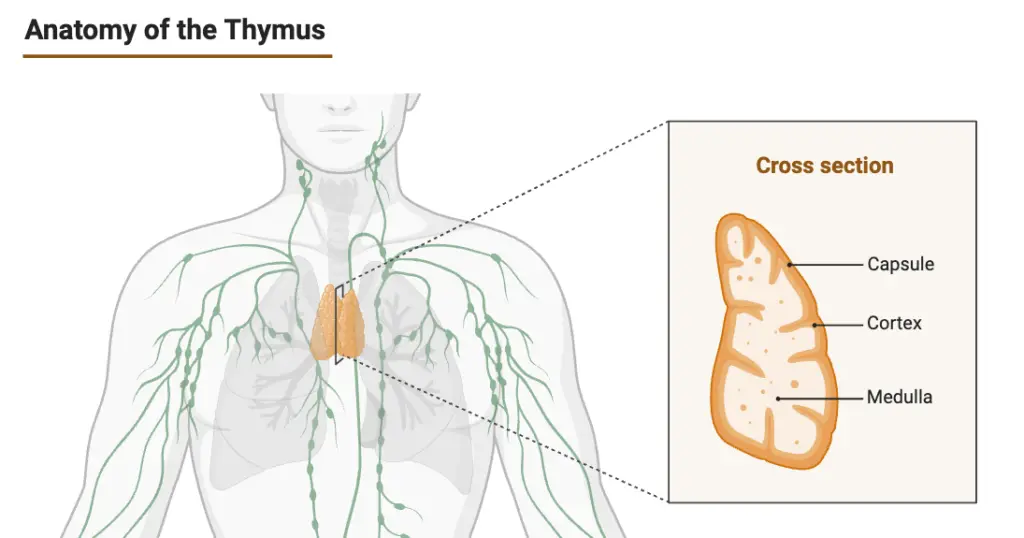
Hormones of Endocrine System and their functions
| Endocrine Gland (Associated Hormone) | Hormones | Class | Effect |
|---|---|---|---|
| Pituitary (anterior) | Growth hormone (GH) | Protein | Promotes growth of body tissues |
| Prolactin (PRL) | Peptide | Promotes milk production | |
| Thyroid-stimulating hormone (TSH) | Glycoprotein | Stimulates thyroid hormone release | |
| Adrenocorticotropic hormone (ACTH) | Peptide | Stimulates hormone release by adrenal cortex | |
| Follicle-stimulating hormone (FSH) | Glycoprotein | Stimulates gamete production | |
| Pituitary (posterior) | Luteinizing hormone (LH) | Glycoprotein | Stimulates androgen production by gonads |
| Antidiuretic hormone (ADH) | Peptide | Stimulates water reabsorption by kidneys | |
| Oxytocin | Peptide | Stimulates uterine contractions during childbirth | |
| Thyroid | Thyroxine (T4), Triiodothyronine (T3) | Amine | Stimulates basal metabolic rate |
| Parathyroid | Calcitonin | Peptide | Reduces blood Ca<sup>2+</sup> levels |
| Parathyroid hormone (PTH) | Peptide | Increases blood Ca<sup>2+</sup> levels | |
| Adrenal (cortex) | Aldosterone | Steroid | Increases blood Na<sup>+</sup> levels |
| Adrenal (medulla) | Epinephrine, norepinephrine | Amine | Stimulates fight-or-flight response |
| Pineal | Melatonin | Amine | Regulates sleep cycles |
| Pancreas | Insulin | Protein | Reduces blood glucose levels |
| Glucagon | Protein | Increases blood glucose levels | |
| Gonads (Testes) | Testosterone | Steroid | Stimulates development of male secondary sex characteristics and sperm production |
| Gonads (Ovaries) | Estrogens and Progesterone | Steroid | Stimulate development of female secondary sex characteristics and prepare the body for childbirth |
| Adrenal (cortex) | Cortisol, corticosterone, cortisone | Steroid | Various metabolic effects |
Organs with Secondary Endocrine Functions
The human body contains several organs that, while not primarily endocrine in nature, play significant roles in hormone production and secretion. These organs with secondary endocrine functions contribute to various physiological processes, enhancing overall homeostasis. Below is a detailed exploration of these organs, outlining their hormonal contributions and associated functions.
- Heart:
- The heart’s atrial wall contains specialized cells that release atrial natriuretic peptide (ANP) when stretched by increased blood volume or pressure.
- ANP promotes sodium excretion by the kidneys, leading to decreased water reabsorption, thus reducing blood volume and pressure.
- Additionally, ANP inhibits renin secretion, thereby influencing the renin-angiotensin-aldosterone system (RAAS) and promoting vasodilation, which further aids in lowering blood pressure and sodium levels.
- Gastrointestinal Tract:
- The GI tract is equipped with endocrine cells located in the mucosa of the stomach and small intestine, releasing hormones that regulate digestion.
- Gastrin is secreted in response to stomach distension and stimulates hydrochloric acid release, aiding food breakdown.
- Secretin is released from the small intestine upon entry of acidic chyme and stimulates bicarbonate release from the pancreas, neutralizing acidity and inhibiting gastric acid secretion.
- Cholecystokinin (CCK) promotes pancreatic enzyme secretion and bile release from the gallbladder, facilitating digestion.
- Other hormones from intestinal cells help regulate glucose metabolism by stimulating insulin secretion and modulating glucagon release.
- Kidneys:
- The kidneys respond to decreased blood flow by releasing renin, which initiates the RAAS, promoting sodium and water reabsorption to increase blood pressure.
- They also produce calcitriol from vitamin D3, essential for calcium homeostasis and activated in response to parathyroid hormone (PTH).
- The kidneys secrete erythropoietin (EPO) when oxygen levels are low, stimulating red blood cell production in the bone marrow, thus enhancing oxygen transport.
- Skeleton:
- Recent research has identified that bones are active in hormone production, notably producing fibroblast growth factor 23 (FGF23) and osteocalcin.
- FGF23 regulates phosphate levels by inhibiting calcitriol formation and increasing phosphorus excretion in response to elevated vitamin D3 or phosphate levels.
- Osteocalcin, produced by osteoblasts, enhances insulin secretion from pancreatic beta cells and increases tissue sensitivity to insulin, promoting glucose utilization.
- Adipose Tissue:
- Adipose tissue secretes several hormones, including leptin, which regulates energy balance and appetite. Higher body fat correlates with increased leptin levels, which act on neurons to suppress hunger and promote energy expenditure.
- Another hormone, adiponectin, is involved in reducing insulin resistance and protecting vascular health; its levels are inversely related to obesity, with lower concentrations observed in overweight individuals.
- Skin:
- The skin contributes to endocrine functions by producing the inactive form of vitamin D3, cholecalciferol, upon exposure to ultraviolet light.
- Cholecalciferol is converted in the liver and kidneys to calcitriol, the active form of vitamin D3, crucial for calcium absorption and immune function.
- Deficiencies in vitamin D can lead to various health issues, including bone disorders such as rickets and osteomalacia.
- Thymus:
- The thymus is primarily an organ of the immune system that produces thymosins, which facilitate T lymphocyte development and differentiation.
- Although their exact mechanisms remain under investigation, thymosins are essential for a functional immune response and have been identified in other tissues, suggesting a broader role in immune regulation.
- Liver:
- The liver plays a vital role in hormone production, secreting insulin-like growth factor (IGF-1), which promotes growth, especially in bone.
- It also produces angiotensinogen, a precursor to angiotensin that raises blood pressure, thrombopoietin, which stimulates platelet production, and hepcidin, crucial for regulating iron metabolism and homeostasis.
| Organ | Major Hormones | Effects |
|---|---|---|
| Heart | Atrial natriuretic peptide (ANP) | Reduces blood volume, blood pressure, and Na+ concentration |
| Gastrointestinal tract | Gastrin, secretin, and cholecystokinin | Aid digestion of food and buffering of stomach acids |
| Gastrointestinal tract | Glucose-dependent insulinotropic peptide (GIP) | Stimulate beta cells of the pancreas to release insulin |
| Kidneys | Renin | Stimulates release of aldosterone |
| Kidneys | Calcitriol | Aids in the absorption of Ca2+ |
| Kidneys | Erythropoietin | Triggers the formation of red blood cells in the bone marrow |
| Skeleton | Osteocalcin | Inhibits production of calcitriol and increases phosphate excretion |
| Skeleton | FGF23 | Inhibits production of calcitriol and increases phosphate excretion |
| Adipose tissue | Leptin | Increases insulin production |
| Adipose tissue | Adiponectin | Promotes satiety signals in the brain |
| Skin | Cholecalciferol | Modified to form vitamin D |
| Thymus (and other organs) | Thymosins | Among other things, aids in the development of T lymphocytes of the immune system |
| Liver | Insulin-like growth factor-1 | Stimulates bodily growth |
| Liver | Angiotensinogen | Raises blood pressure |
| Liver | Thrombopoietin | Causes increase in platelets |
| Liver | Hepcidin | Blocks release of iron into body fluids |
Development and Aging of the Endocrine System
The development and aging of the endocrine system are integral to understanding both physiological growth and the changes that occur throughout life. This system emerges from all three embryonic germ layers, leading to a diverse range of hormones and functions that influence multiple body systems. As individuals age, the endocrine system experiences various alterations that can significantly impact hormone production and regulation.
- The embryonic origins of endocrine glands are derived from:
- Mesoderm: Forms glands that produce steroid hormones, including the gonads and adrenal cortex.
- Endoderm and Ectoderm: Generate glands that produce amine, peptide, and protein hormones, such as the thyroid, parathyroid, pancreas, thymus, and parts of the pituitary gland.
- Pituitary Gland Development:
- The anterior pituitary originates from oral ectoderm, while the posterior pituitary develops from neural ectoderm at the hypothalamus.
- The pineal gland also derives from the ectoderm.
- Aging Effects on the Endocrine System:
- As individuals age, structural changes in glands occur, influencing their functionality.
- For instance, in the anterior pituitary:
- Vascularization diminishes, and connective tissue content increases.
- Resulting in a decline in the production of hormones such as human growth hormone (HGH), contributing to decreased muscle mass commonly seen in older adults.
- Adrenal Gland Changes:
- The adrenal glands experience increased fibrous tissue, leading to a reduction in cortisol and aldosterone production.
- However, the secretion of epinephrine and norepinephrine remains stable throughout aging.
- Menopause and Ovarian Function:
- Aging is closely linked to menopause, characterized by a decrease in ovarian size and weight.
- Ovaries become less responsive to gonadotropins, leading to diminished estrogen and progesterone levels.
- The decline in these hormones can result in several health issues, including osteoporosis, atherosclerosis, and hyperlipidemia.
- Testosterone Decline in Males:
- Men experience a gradual decline in testosterone levels, known as andropause, which typically occurs less dramatically than estrogen decline in women.
- This reduction rarely affects sperm production until much later in life, allowing men to retain reproductive capability longer than women, though sperm quality may decrease over time.
- Thyroid Gland Activity:
- Aging leads to decreased production of thyroid hormones, causing a gradual decline in the basal metabolic rate.
- This reduction can contribute to decreased body heat production and increased body fat levels.
- Parathyroid Hormone Dynamics:
- With age, parathyroid hormone levels tend to increase, potentially due to decreased dietary calcium.
- Elevated parathyroid hormone, coupled with reduced calcitonin and estrogen levels in women, may lead to osteoporosis, affecting bone density.
- Glucose Metabolism:
- Aging impacts glucose metabolism, resulting in more rapid spikes in blood glucose levels that take longer to normalize.
- Increased insulin resistance and glucose intolerance are common, with approximately 27 percent of Americans aged 65 and older affected by diabetes.
Disorders of Endocrine System/Endocrine Glands
Diseases and disorders of the endocrine system arise from imbalances in hormone production, either through hypersecretion or hyposecretion. Such conditions can significantly impact various physiological processes, necessitating a clear understanding of their mechanisms, symptoms, and implications. The following points outline the key disorders associated with different endocrine glands:
- Pituitary Gland Disorders:
- Hypersecretion:
- Gigantism and Acromegaly result from excess secretion of growth hormone due to the overproduction of growth hormone-releasing hormone by the hypothalamus.
- Gigantism is characterized by abnormal height and large bone structure during childhood.
- Acromegaly manifests in adulthood, leading to enlarged extremities and thickened bones and soft tissues.
- Gigantism and Acromegaly result from excess secretion of growth hormone due to the overproduction of growth hormone-releasing hormone by the hypothalamus.
- Hyposecretion:
- Ischaemic Necrosis occurs when insufficient stimulation leads to reduced hormone production by target glands.
- Dwarfism is a condition stemming from a deficiency of growth hormone during childhood, resulting in significantly reduced stature.
- Diabetes Insipidus arises from insufficient antidiuretic hormone (ADH), leading to excessive loss of water through the kidneys.
- Hypersecretion:
- Thyroid Gland Disorders:
- Hypersecretion:
- Hyperthyroidism is characterized by elevated levels of thyroid hormones (T3 and T4) and encompasses conditions such as:
- Grave’s Disease, an autoimmune disorder where antibodies mimic thyroid-stimulating hormone, accounting for approximately 75% of hyperthyroidism cases.
- Toxic Nodular Goiter, where one or more nodules in the thyroid gland become hyperactive and secrete excess hormones.
- Hyperthyroidism is characterized by elevated levels of thyroid hormones (T3 and T4) and encompasses conditions such as:
- Hyposecretion:
- Hypothyroidism leads to insufficient thyroid hormone production, often resulting in simple goiter, characterized by thyroid gland enlargement due to a lack of T3 and T4.
- This disorder affects metabolic processes and may necessitate surgical intervention to remove excess thyroid tissue.
- Hypersecretion:
- Adrenal Gland Disorders:
- Hypersecretion:
- Cushing’s Syndrome results from excess cortisol production, leading to symptoms such as:
- Increased tissue breakdown, facial adiposity, reduced protein synthesis, and osteoporosis.
- Increased production of mineralocorticoids (e.g., aldosterone) can cause excessive ion and water retention, adversely affecting kidney function.
- Cushing’s Syndrome results from excess cortisol production, leading to symptoms such as:
- Hyposecretion:
- Reduced glucocorticoid levels lead to diminished gluconeogenesis, resulting in low blood glucose and muscle weakness.
- A deficiency in mineralocorticoids disrupts kidney function, causing sodium depletion and potassium retention.
- Hypersecretion:
- Parathyroid Gland Disorders:
- Hypersecretion:
- Hyperparathyroidism is characterized by elevated parathyroid hormone levels, often due to a benign tumor, resulting in increased blood calcium levels.
- Symptoms include muscle weakness, gastrointestinal issues (anorexia, constipation), and renal calculi formation.
- Hyposecretion:
- Hypoparathyroidism is rarer and leads to hypocalcemia, manifesting as tetany, anxiety, or paraesthesia, characterized by painful muscle spasms and abnormal hand and foot positions.
- Hypersecretion:
- Pancreatic Islet Disorders:
- Diabetes Mellitus:
- The most prevalent endocrine disorder, leading to significant metabolic disturbances in carbohydrates and fats.
- Type 1 Diabetes Mellitus occurs primarily in children due to complete insulin deficiency, posing life-threatening risks if not managed.
- Type 2 Diabetes Mellitus is more common, comprising about 90% of cases. It often develops gradually and can remain undiagnosed for extended periods, resulting in long-term complications.
- Diabetes Mellitus:
Functions of Endocrine System
Here are the primary functions of the endocrine system:
- Hormone Production:
- The primary role of the endocrine system is to produce hormones that affect various physiological processes throughout the body.
- Regulation of Metabolism:
- Hormones like thyroid hormones (T3 and T4) regulate metabolic rates, influencing how the body converts food into energy.
- Growth and Development:
- Growth hormone (GH) and other hormones play essential roles in physical growth, development during childhood, and the maturation of tissues and organs.
- Reproductive Functions:
- Hormones such as estrogen, progesterone, and testosterone regulate sexual development, reproductive cycles, and fertility.
- Response to Stress:
- The adrenal glands produce hormones like cortisol and adrenaline (epinephrine) that help the body respond to stress by increasing heart rate, blood pressure, and energy availability.
- Homeostasis Maintenance:
- The endocrine system helps maintain homeostasis by regulating internal conditions such as blood sugar levels (insulin and glucagon), fluid balance (antidiuretic hormone), and electrolyte levels (aldosterone).
- Regulation of Mood and Behavior:
- Hormones can influence mood and emotional well-being. For instance, serotonin, produced in part by the pineal gland, plays a role in mood regulation.
- Immune Function:
- Hormones like thymosins, produced by the thymus, assist in the development and differentiation of T lymphocytes, crucial for immune response.
- Calcium Regulation:
- The parathyroid hormone (PTH) and calcitonin regulate calcium levels in the blood, which is vital for bone health and muscle function.
- Blood Sugar Regulation:
- Insulin and glucagon work together to regulate blood glucose levels, ensuring the body has enough energy while preventing hyperglycemia or hypoglycemia.
- Water Balance:
- Antidiuretic hormone (ADH) helps control water retention by the kidneys, influencing urine production and maintaining hydration.
- Sleep-Wake Cycle Regulation:
- The pineal gland secretes melatonin, which helps regulate sleep patterns by responding to light exposure.
- Lipid Metabolism:
- Hormones such as leptin, produced by adipose tissue, influence energy balance and fat storage.
FAQ
What is the endocrine system?
The endocrine system is a network of glands that produce and release hormones into the bloodstream. These hormones act as chemical messengers, regulating various bodily functions and maintaining homeostasis.
What are the main glands of the endocrine system?
The major glands of the endocrine system include the hypothalamus, pituitary gland, thyroid gland, parathyroid glands, adrenal glands, pancreas, ovaries (in females), and testes (in males).
What are hormones?
Hormones are chemical substances produced by the endocrine glands that travel through the bloodstream to target cells or organs. They regulate processes such as growth and development, metabolism, reproduction, and mood.
How do hormones work?
Hormones bind to specific receptor sites on target cells or organs, triggering a response within those cells. This response can involve changes in gene expression, cellular activity, or the release of other hormones.
What does the pituitary gland do?
Often referred to as the “master gland,” the pituitary gland produces and releases hormones that control the functions of other endocrine glands. It regulates growth, reproduction, metabolism, and the balance of other hormones in the body.
What is the role of the hypothalamus in the endocrine system?
The hypothalamus acts as the control center for the endocrine system. It produces hormones that regulate the pituitary gland and influences other endocrine glands. The hypothalamus also plays a role in maintaining body temperature, hunger, thirst, and sleep.
What is the function of the thyroid gland?
The thyroid gland produces hormones that regulate metabolism, growth, and development. It helps control the rate at which the body uses energy, maintains body temperature, and influences the function of various organs.
What is the role of the adrenal glands?
The adrenal glands produce hormones that are essential for stress response and regulation of metabolism. They secrete cortisol, which helps the body respond to stress, and aldosterone, which regulates electrolyte balance and blood pressure.
How does the pancreas contribute to the endocrine system?
The pancreas produces hormones such as insulin and glucagon, which are involved in regulating blood sugar levels. Insulin helps lower blood sugar, while glucagon raises it, maintaining a delicate balance necessary for proper cellular function.
How can endocrine disorders be diagnosed and treated?
Endocrine disorders are diagnosed through a combination of medical history, physical examination, blood tests, and imaging studies. Treatment options may include hormone replacement therapy, medications, surgery, or lifestyle modifications, depending on the specific disorder and its underlying cause. A specialist called an endocrinologist is typically involved in the diagnosis and management of endocrine disorders.
- Waugh A and Grant A. (2004) Anatomy and Physiology. Ninth Edition. Churchill Livingstone. (Page: 685 – 735)
- Hiller-Sturmhöfel S, Bartke A. The endocrine system: an overview. Alcohol Health Res World. 1998;22(3):153-64. PMID: 15706790; PMCID: PMC6761896.
- Campbell M, Jialal I. Physiology, Endocrine Hormones. [Updated 2022 Sep 26]. In: StatPearls [Internet]. Treasure Island (FL): StatPearls Publishing; 2024 Jan-. Available from: https://www.ncbi.nlm.nih.gov/books/NBK538498/
- https://training.seer.cancer.gov/anatomy/endocrine/
- https://www.hopkinsmedicine.org/health/wellness-and-prevention/anatomy-of-the-endocrine-system
- https://opentextbc.ca/biology/chapter/11-4-endocrine-system/
- https://uta.pressbooks.pub/histology/chapter/endocrine-system/
- https://uomustansiriyah.edu.iq/media/lectures/2/2_2017_03_08!01_26_15_PM.pdf
- https://vetmed.tamu.edu/peer/wp-content/uploads/sites/72/2020/04/7-Endocrine-System.pdf
- http://fblt.cz/en/skripta/xi-regulacni-mechanismy-1-endokrinni-regulace/1-funkcni-morfologie-endokrinniho-systemu/
- https://www.physio-pedia.com/Exercise_Endocrine_System_Interaction
- https://www.epa.gov/endocrine-disruption/overview-endocrine-system
- https://www.hopkinsmedicine.org/health/wellness-and-prevention/anatomy-of-the-endocrine-system
- https://biologydictionary.net/endocrine-system/
- https://www.biologydiscussion.com/chemical-coordination/endocrine-glands-of-human-beings-with-diagram/5124
- https://www.biologydiscussion.com/endocrinology/endocrine-gland-definition-development-and-classification/18427
- Text Highlighting: Select any text in the post content to highlight it
- Text Annotation: Select text and add comments with annotations
- Comment Management: Edit or delete your own comments
- Highlight Management: Remove your own highlights
How to use: Simply select any text in the post content above, and you'll see annotation options. Login here or create an account to get started.